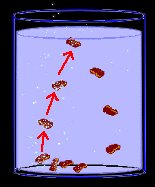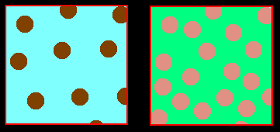



Density is a measure of how much material is packed into an object of given size. Here's a fun demonstration that will show you what happens to an object in a liquid when its density decreases.
You'll need a jar, some clear carbonated pop (ginger ale will do), and some raisins. Fill the jar with the pop and throw in some raisins. They will sink to the bottom, because they are denser than the liquid they're in.
But wait a few minutes. What happens? First you'll see bubbles of carbon dioxide collect around the raisins. Carbon dioxide is the gas that is dissolved in carbonated drinks that makes them fizzy. Bubbles of gas form in the liquid as the CO2 undissolves, and rise to the surface, because gasses are less dense than liquids.
 As the bubbles form around a raisin, they will lift the raisin to the surface. Then the bubbles escape into the air, and the raisin falls. This happens over and over, making the raisins in the jar continually float to the surface and sink. Try it ... it's amazing!
As the bubbles form around a raisin, they will lift the raisin to the surface. Then the bubbles escape into the air, and the raisin falls. This happens over and over, making the raisins in the jar continually float to the surface and sink. Try it ... it's amazing!
Density is a measure of how much material is packed into an object of given size. Below, the material on the left is not very dense; its molecules are far apart.
The material on the right is made up of molecules that are much closer together, so it is much denser.

A raisin is denser than pop, so it sinks. A bubble of CO2 is much less dense than pop, so it floats quickly to the surface. When the bubbles cling to a raisin, the raisin and bubble together become slightly less dense than the pop, so they rise to the surface.
|
 Dr. Deadly's Science Lab Question Dr. Deadly's Science Lab Question
"Which floats in water, an orange, or the same orange
with the peel removed? Explain."
No answer this time. Guess what will happen,
and why. Then try it and see. Were you right?
|
Science Lab | Resources
|

